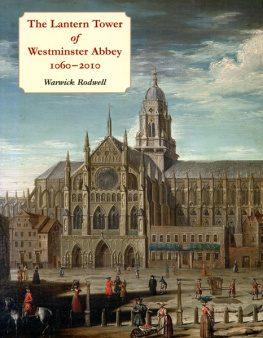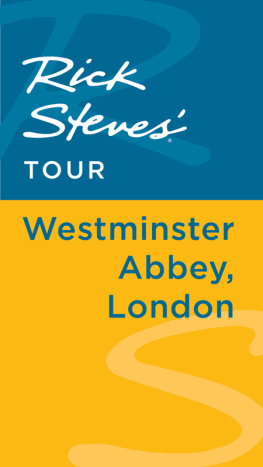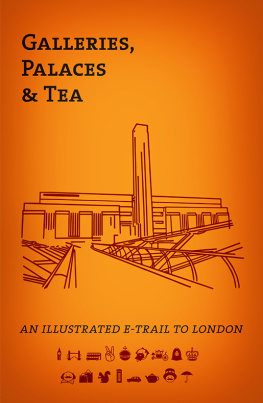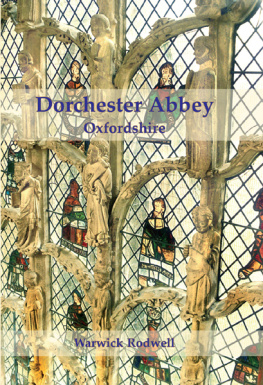Rodwell Warwick - The Lantern Tower of Westminster Abbey, 1060-2010
Here you can read online Rodwell Warwick - The Lantern Tower of Westminster Abbey, 1060-2010 full text of the book (entire story) in english for free. Download pdf and epub, get meaning, cover and reviews about this ebook. year: 2010, publisher: Oxbow Books, Limited, genre: Science fiction. Description of the work, (preface) as well as reviews are available. Best literature library LitArk.com created for fans of good reading and offers a wide selection of genres:
Romance novel
Science fiction
Adventure
Detective
Science
History
Home and family
Prose
Art
Politics
Computer
Non-fiction
Religion
Business
Children
Humor
Choose a favorite category and find really read worthwhile books. Enjoy immersion in the world of imagination, feel the emotions of the characters or learn something new for yourself, make an fascinating discovery.
- Book:The Lantern Tower of Westminster Abbey, 1060-2010
- Author:
- Publisher:Oxbow Books, Limited
- Genre:
- Year:2010
- Rating:3 / 5
- Favourites:Add to favourites
- Your mark:
- 60
- 1
- 2
- 3
- 4
- 5
The Lantern Tower of Westminster Abbey, 1060-2010: summary, description and annotation
We offer to read an annotation, description, summary or preface (depends on what the author of the book "The Lantern Tower of Westminster Abbey, 1060-2010" wrote himself). If you haven't found the necessary information about the book — write in the comments, we will try to find it.
The Lantern Tower of Westminster Abbey, 1060-2010 — read online for free the complete book (whole text) full work
Below is the text of the book, divided by pages. System saving the place of the last page read, allows you to conveniently read the book "The Lantern Tower of Westminster Abbey, 1060-2010" online for free, without having to search again every time where you left off. Put a bookmark, and you can go to the page where you finished reading at any time.
Font size:
Interval:
Bookmark:
Published by
Oxbow Books, Oxford, UK
for the Dean and Chapter of Westminster
Oxbow Books, Warwick Rodwell
and the Dean and Chapter of Westminster, 2010
ISBN 978-1-84217-979-6
PDF ISBN: 9781842177617
EPUB ISBN: 9781842177594
PRC ISBN: 9781842177600
Westminster Abbey Occasional Papers (series 3), no. 1
A CIP record for this book is available from the British Library
This book is available direct from:
Oxbow Books, Oxford, UK
(Phone: 01865-241249; Fax: 01865-794449)
and
The David Brown Book Company
PO Box 511, Oakville, CT 06779, USA
(Phone: 860-945-9329; Fax: 860-945-9468)
or from our website
www.oxbowbooks.com
Front cover:
Detail from an oil painting by Pietro Fabris, c. 1735, showing one
of Nicholas Hawksmoors proposals for building a crossing tower (scheme 4, version iii). WA Lib. Coll.
Back cover:
Sir Christopher Wrens model of his proposed 400-foot crossing tower and spire, 1710. WA Lib. Coll.
Printed in Great Britain by
Cambrian Printers
Aberystwyth, Wales
Contents
by The Very Reverend Dr John Hall, Dean of Westminster |
by Richard Gem |
Foreword
by The Very Reverend Dr John Hall, Dean of Westminster
Most of us take our surroundings for granted. We often depend on someone opening our eyes, for example, to the glory of a building about to be lost. John Betjemans vigorous and successful campaign to save the wonderful St Pancras Station is remembered as creating a turning point in the 1960s in public opinion of Victorian architecture. It was an uphill struggle but people came to see.
When we do come to see, it is remarkable what we eventually discover. Before I became Dean, I was familiar with the Abbey, but in fact knew little of its architecture or history. I needed a friends eyes to see the iconic western towers as creatures of the eighteenth century. The stylistic dependence of Barrys Palace of Westminster on the Abbeys Lady Chapel was for me another startling moment of revelation. I remember wondering many years ago why the great crossing of the Abbey church was surmounted by such a stumpy little tower. I came to no conclusion and the thought passed to the back of my mind, to be recalled later when it was again drawn to my attention.
Now we know that the stumpy little tower at the crossing of the Abbey was never intended by anyone. It is simply that the building has never been finished. Now our eyes are open, the Dean and Chapter hope we shall be able to finish the work. We look forward to seeing what might be proposed. This book will greatly help those hoping to make a proposal for the design of a lantern or corona as well as those of us considering what is proposed.
There could be no better guide than Professor Warwick Rodwell, the Abbeys consultant archaeologist, in helping us open our eyes to what has been built at the crossing and what has been proposed at different times in the Abbeys history. In record time, he has detected a great deal of information and drawn persuasive conclusions. His work is a joy to read and will open the eyes of many. We are truly grateful.
Acknowledgements
I am grateful to the Dean of Westminster, the Very Revd Dr John Hall, for inviting me to write this account of the history and archaeology of the lantern tower. It could not have been achieved without the generous collaboration of my colleagues at the Abbey: the support and encouragement provided by Sir Stephen Lamport, KCVO (Receiver General) has been invaluable; Dr Tony Trowles (Librarian and Head of the Collections) and Dr Richard Mortimer (Keeper of the Muniments) facilitated access to archives and artefacts for study; Miss Christine Reynolds (Assistant Keeper of the Muniments) was unstinting in her help with searching out and copying documents and illustrations; Clive Richardson (Structural Engineer) kindly shared the results of his investigations and discussed structural issues at length with me; similarly, John Burton (Surveyor of the Fabric) discussed architectural matters with me; and Jim Vincent (Clerk of the Works) provided practical assistance with access and investigation.
Tony Davies and Bill Mowatt of The Downland Partnership expeditiously carried out measured surveys of the crossing with their customary attention to detail, despite the awkward conditions, and Mrs Erica Utsi conducted ground-penetrating radar surveys (GPR) of the floors in the crossing and transepts. Rosie Daswani skilfully undertook the digital cleaning and enhancement of some of the images. Dr Richard Gem, OBE, kindly contributed the appendix to this study and made other helpful suggestions in the text. The manuscript additionally benefitted from the scrutiny of Drs Trowles and Mortimer and Miss Reynolds. For access and permission to study the painting of Westminster Abbey at Woodperry House, I am indebted to Rory Fleming. For further ideas and discussion I must acknowledge Tim Tatton-Brown, Diane Gibbs-Rodwell and Alan Rome, OBE. Finally, my thanks go to David Brown and his colleagues at Oxbow Books for producing this volume so expeditiously: in particular Julie Blackmore, Julie Gardiner and Val Lamb.
The majority of the illustrations are the property and copyright of the Dean and Chapter of Westminster, including those generated by the author; items obtained from other sources are individually credited.
Westminster Abbey: the Crossing
The history and architecture of Westminster Abbey have been studied by many scholars, and one might be forgiven for supposing that we know everything there is to know about this great building. But that is far from being the case, and several key features of the Abbeys architecture have disappeared, or have never been completed according to the intentions of their designer. The lantern tower, punctuating the point at which the four arms of the church meet (the crossing), is a case in point. It has a long and extraordinarily complex history. What we see emerging from the roof today is merely the stump of a great architectural feature that has never been completed. [] Neither its date of construction, nor the reason for its abandonment, has been satisfactorily demonstrated. However, there can be little doubt that it was intended to be a worthy successor to the two previous lantern towers that are known to have existed.
No attempt has hitherto been made to write the history of the crossing tower, but in order to understand the historical and architectural significance of the existing lantern and to assess what might possibly be done in the future to enhance or complete it it is first necessary to elucidate how the structure arrived at its present form. That is the result of multiple interventions over a period of 950 years.

The modern roofscape of Westminster Abbey: aerial view from the south-west. English Heritage Photo Library
Edward the Confessors Crossing Tower and Lantern
The story of the Westminster lantern tower begins much earlier than the present structure, almost one thousand years ago, with Edward the Confessor. Shortly after he ascended the English throne in 1042, he began to rebuild Westminster Abbey in the Romanesque style that was then current in Normandy. At the time of his death in 1066, he had completed the eastern arm, the north and south transepts and half of the nave. A snapshot of Edwards ]

Font size:
Interval:
Bookmark:
Similar books «The Lantern Tower of Westminster Abbey, 1060-2010»
Look at similar books to The Lantern Tower of Westminster Abbey, 1060-2010. We have selected literature similar in name and meaning in the hope of providing readers with more options to find new, interesting, not yet read works.
Discussion, reviews of the book The Lantern Tower of Westminster Abbey, 1060-2010 and just readers' own opinions. Leave your comments, write what you think about the work, its meaning or the main characters. Specify what exactly you liked and what you didn't like, and why you think so.







